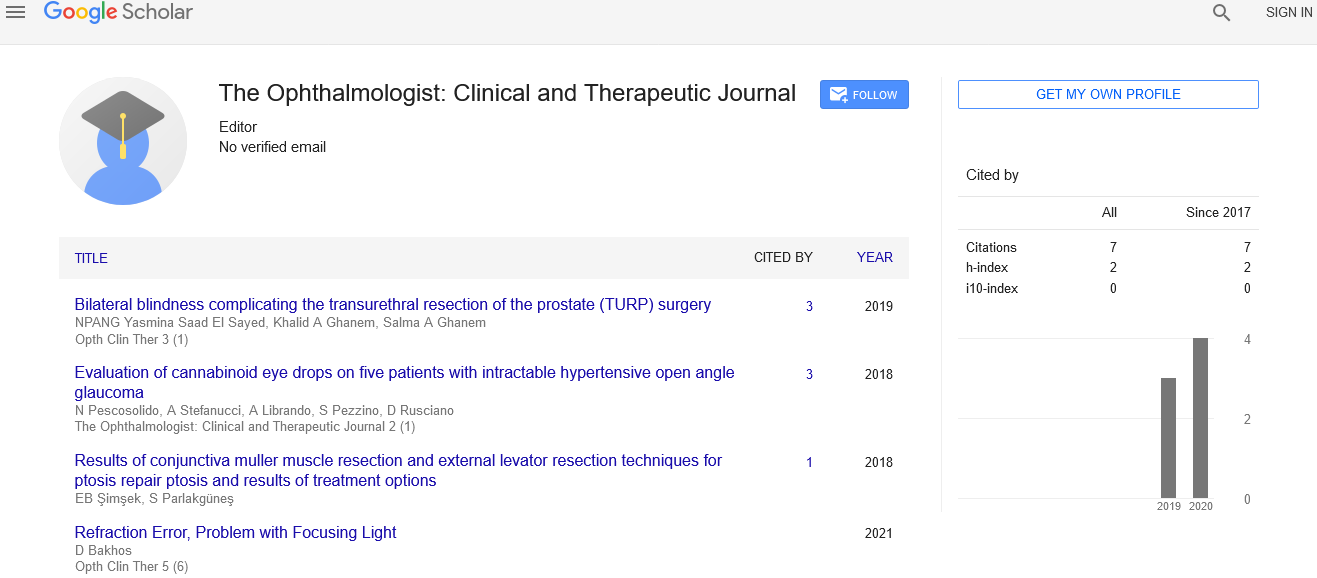Delineating anticipation for glaucoma
Received: 10-Jan-2022, Manuscript No. PULOCTJ-22-4253; Editor assigned: 12-Jan-2022, Pre QC No. . PULOCTJ-22-4253(PQ); Accepted Date: Jan 12, 2022; Reviewed: 18-Jan-2022 QC No. PULOCTJ-22-4253; Revised: 21-Jan-2022, Manuscript No. PULOCTJ-22-4253(R); Published: 11-Feb-2022, DOI: DOI:10.37532/puloctj.22.6.1.1
Citation: Wang N. Delineating anticipation for glaucoma. Opth Clin Ther. 2022;6(1):1.
This open-access article is distributed under the terms of the Creative Commons Attribution Non-Commercial License (CC BY-NC) (http://creativecommons.org/licenses/by-nc/4.0/), which permits reuse, distribution and reproduction of the article, provided that the original work is properly cited and the reuse is restricted to noncommercial purposes. For commercial reuse, contact reprints@pulsus.com
Abstract
Glaucoma is the main source of irreversible visual impairment around the world; be that as it may, vision misfortune coming about because of glaucoma for the most part can be forestalled through early distinguishing proof and ideal execution of treatment. As of late, Polygenic Danger Scores (PRSs) have shown guarantee in delineating individual danger and anticipation for essential Open-Point Glaucoma (POAG) to decrease infection trouble. Incorporating PRS testing into clinical practice is turning out to be progressively reasonable; be that as it may, little is had some significant awareness of the mentalities of patients toward such testing. 1,000 one hundred 69 people (reaction rate, 49%) with POAG finished the study assessing their perspectives towards polygenic danger testing for glaucoma.
Key Words
Polygenic danger scores, POAG, intraocular pressure
Introduction
Glaucoma is at present the main source of irreversible visual impairment worldwide and the second most normal reason for vision misfortune after cataract. It is a hereditarily mind boggling, heterogeneous sickness that appears as moderate optic neuropathy with relating visual field defects. Primary Open-Point Glaucoma (POAG) is the most widely recognized subtype, influencing 76 million people worldwide and anticipated to influence 112 million individuals by 2040. Raised Intraocular Pressure (IOP) is the main realized modifiable danger factor for glaucoma. Flow treatment standards center around diminishing IOP, and this approach is profoundly compelling at easing back infection movement as well similar to the main proof based treatment choice at present available. Despite the danger of irreversible visual impairment, even in created nations with astounding medical services arrangements, roughly 50% of all people with glaucoma remain undiagnosed. This is generally in light of the fact that the condition is asymptomatic in the beginning phases of illness, and furthermore shows that current screening techniques are deficient. By and large, glaucoma hazard appraisal has been founded on the combined amount of clinical highlights and customary danger factors. These incorporate IOP, age, heritage, and family history. Glaucoma pervasiveness varies between various nationalities: those with African parentage are at more serious danger of POAG than those with European ancestry. Genetic danger generally has been assessed through family ancestry, with a 9.2-crease expanded danger for first-degree family members of patients with glaucoma contrasted and controls. Glaucoma is quite possibly the most heritable human infection, with the heritability of POAG supported by both uncommon and normal variants. High-penetrance variations in qualities like MYOC, OPTN, and TBK1 represent up to 5% of grown-up beginning POAG.
Result
Sociodemographic, wellbeing, discernment, and passionate variables were analyzed to survey relationship with interest in PRS testing. Interest in PRS testing was assessed through surveying probability to step through the exam to anticipate individual danger of sickness and infection seriousness, and regardless of whether the individual would prescribe the test to relatives or others. Our outcomes show solid interest in the test, with 69.4% of people (798 of 1150) demonstrating an astuteness in testing before finding, had it been accessible. Specifically, interest was found in those from a metropolitan region, the people who saw their danger of creating glaucoma as higher (OR, 2.05; 95% CI, 1.28-3.29; P = 0.003), and the individuals who were stressed over creating glaucoma (OR, 2.07; 95% CI, 1.27-3.37; P = 0.004). Individuals who were keen on testing were bound to change their eye wellbeing looking for aims and to prescribe testing to relatives and others, as well as to go through testing for forecast. Altogether, 2369 ANZRAG members were welcome to partake in the review, with 1169 finishing the poll, yielding a reaction pace of 49.3%. In rundown, 53.5% of respondents were ladies, 92.9% were White, and 51.7% had a training level of more than auxiliary school. The mean age of the partner was 75.7 ± 10.3 years, with 93.8% being more seasoned than 60 years. A positive family background of glaucoma was accounted for by 65.9% of respondents, with 87.5% of those with a positive family ancestry having somewhere around 1 impacted first-degree relative. Of the 1200 members who didn’t react, restricted segment and clinical information were acquired from the ANZRAG data set. In outline, 55.2% of nonrespondents were ladies and 83.1% were White. The mean time of nonrespondents was 77.7 ± 14.5 years. Respondents and nonrespondents didn’t vary by orientation, age at conclusion, family ancestry, or residency. In any case, respondents were bound to be more youthful (P < 0.001), to have White lineage (P < 0.001), and to have less serious glaucoma reflected by nonadvanced sickness characterization (P < 0.001) and pace of legitimate visual deficiency (P < 0.001) contrasted and nonrespondents.





